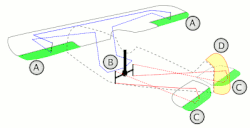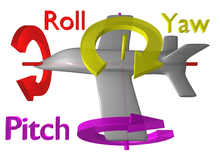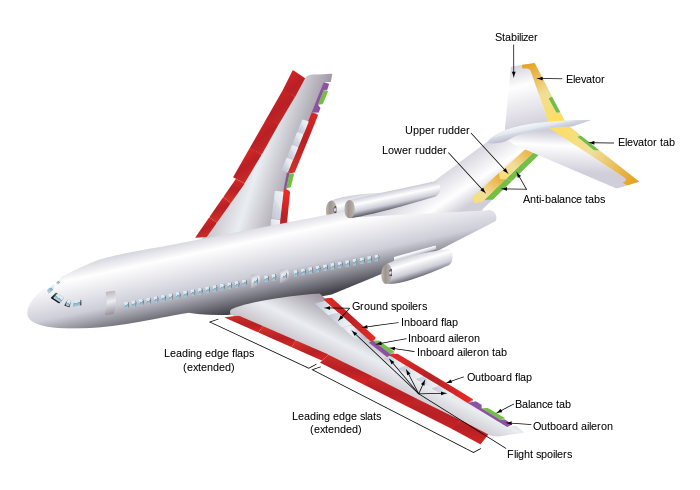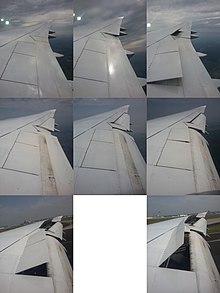Cool Airplane That Flies and Makes a Name Drawing

Basic aircraft control surfaces and movement.
Aircraft flight command surfaces are aerodynamic devices allowing a pilot to suit and command the shipping'southward flight mental attitude.
Development of an effective gear up of flight command surfaces was a disquisitional advance in the development of aircraft. Early efforts at fixed-wing aircraft design succeeded in generating sufficient lift to get the shipping off the footing, simply once aloft, the aircraft proved uncontrollable, often with disastrous results. The development of effective flight controls is what allowed stable flight.
This article describes the control surfaces used on a fixed-wing aircraft of conventional blueprint. Other fixed-wing shipping configurations may use different control surfaces only the bones principles remain. The controls (stick and rudder) for rotary fly aircraft (helicopter or autogyro) accomplish the same motions nigh the three axes of rotation, but manipulate the rotating flight controls (main rotor disk and tail rotor deejay) in a completely different manner.
Flight command surfaces are operated past aircraft flight command systems.
Evolution [edit]
The Wright brothers are credited with developing the first practical control surfaces. It is a main part of their patent on flight.[1] Different modernistic control surfaces, they used wing warping.[ii] In an endeavour to circumvent the Wright patent, Glenn Curtiss made hinged command surfaces, the same type of concept first patented some four decades before in the United Kingdom. Hinged control surfaces accept the advantage of not causing stresses that are a problem of wing warping and are easier to build into structures.
Axes of move [edit]

Rotation around the three axes

Mnemonics to call back bending names
An aircraft is free to rotate around three axes that are perpendicular to each other and intersect at its centre of gravity (CG). To control position and direction a pilot must be able to command rotation well-nigh each of them.
Transverse axis [edit]
The transverse axis, also known as lateral axis,[3] passes through an aircraft from wingtip to wingtip. Rotation well-nigh this axis is called pitch. Pitch changes the vertical management that the aircraft'south nose is pointing. The elevators are the primary control surfaces for pitch.
Longitudinal axis [edit]
The longitudinal axis passes through the shipping from olfactory organ to tail. Rotation about this axis is chosen whorl.[3] The athwart displacement about this axis is called depository financial institution.[4] The pilot changes banking concern angle by increasing the elevator on one wing and decreasing it on the other. This differential lift causes rotation around the longitudinal axis. The ailerons are the master control of bank. The rudder also has a secondary effect on bank.
Vertical axis [edit]
The vertical axis passes through an shipping from top to lesser. Rotation about this axis is called yaw.[3] Yaw changes the direction the aircraft's olfactory organ is pointing, left or correct. The main command of yaw is with the rudder. Ailerons likewise accept a secondary effect on yaw.
It is important to note that these axes motion with the aircraft, and change relative to the globe equally the shipping moves. For example, for an aircraft whose left wing is pointing directly downwards, its "vertical" centrality is parallel with the ground, while its "transverse" axis is perpendicular to the basis.
Master control surfaces [edit]
The chief control surfaces of a fixed-wing shipping are attached to the airframe on hinges or tracks so they may move and thus deflect the air stream passing over them. This redirection of the air stream generates an unbalanced force to rotate the plane about the associated centrality.

Flight control surfaces of Boeing 727
Ailerons [edit]

Ailerons are mounted on the trailing edge of each wing near the wingtips and movement in opposite directions. When the airplane pilot moves the stick left, or turns the wheel counter-clockwise, the left aileron goes up and the correct aileron goes downwardly. A raised aileron reduces elevator on that wing and a lowered ane increases lift, then moving the stick left causes the left wing to drop and the correct fly to ascent. This causes the aircraft to gyre to the left and begin to turn to the left. Centering the stick returns the ailerons to neutral maintaining the bank angle. The aircraft will continue to turn until reverse aileron motion returns the bank bending to nothing to fly directly.
Elevator [edit]
The lift is a moveable part of the horizontal stabilizer, hinged to the back of the fixed part of the horizontal tail. The elevators movement upwards and down together. When the pilot pulls the stick backward, the elevators go up. Pushing the stick forward causes the elevators to become downwards. Raised elevators push downwards on the tail and crusade the nose to pitch up. This makes the wings fly at a college bending of attack, which generates more lift and more drag. Centering the stick returns the elevators to neutral and stops the modify of pitch. Some aircraft, such as an MD-eighty, use a servo tab within the elevator surface to aerodynamically move the chief surface into position. The direction of travel of the control tab will thus exist in a management opposite to the master control surface. It is for this reason that an Dr.-80 tail looks like it has a 'split' elevator system.
In the canard arrangement, the elevators are hinged to the rear of a foreplane and motility in the opposite sense, for example when the pilot pulls the stick back the elevators go downward to increase the lift at the front and elevator the nose upwards.
Rudder [edit]
The rudder is typically mounted on the abaft border of the vertical stabilizer, part of the empennage. When the airplane pilot pushes the left pedal, the rudder deflects left. Pushing the right pedal causes the rudder to deflect right. Deflecting the rudder right pushes the tail left and causes the nose to yaw to the correct. Centering the rudder pedals returns the rudder to neutral and stops the yaw.
Secondary effects of controls [edit]
Ailerons [edit]
The ailerons primarily control roll. Whenever lift is increased, induced drag is besides increased. When the stick is moved left to curlicue the aircraft to the left, the right aileron is lowered which increases lift on the correct wing and therefore increases induced drag on the right wing. Using ailerons causes agin yaw, meaning the nose of the shipping yaws in a direction reverse to the aileron application. When moving the stick to the left to depository financial institution the wings, adverse yaw moves the nose of the aircraft to the correct. Adverse yaw is more pronounced for calorie-free aircraft with long wings, such as gliders. It is counteracted by the pilot with the rudder. Differential ailerons are ailerons which accept been rigged such that the downgoing aileron deflects less than the upward-moving ane, reducing agin yaw.
Rudder [edit]
The rudder is a central command surface which is typically controlled by pedals rather than at the stick. It is the primary means of controlling yaw—the rotation of an airplane virtually its vertical centrality. The rudder may also exist called upon to counter-act the adverse yaw produced past the curlicue-control surfaces.
If rudder is continuously practical in level flight the aircraft will yaw initially in the direction of the applied rudder – the primary effect of rudder. After a few seconds the shipping will tend to bank in the direction of yaw. This arises initially from the increased speed of the wing reverse to the direction of yaw and the reduced speed of the other fly. The faster wing generates more elevator so rises, while the other wing tends to get down considering of generating less lift. Continued awarding of rudder sustains rolling tendency because the aircraft flying at an bending to the airflow - skidding towards the forrad fly. When applying right rudder in an aircraft with dihedral the left hand wing will have increased angle of assail and the right mitt wing will have decreased bending of attack which will result in a roll to the right. An aircraft with anhedral volition evidence the contrary effect. This effect of the rudder is ordinarily used in model aircraft where if sufficient dihedral or polyhedral is included in the wing design, primary roll command such as ailerons may be omitted altogether.
Turning the aircraft [edit]
Different turning a gunkhole, changing the direction of an aircraft normally must exist done with the ailerons rather than the rudder. The rudder turns (yaws) the aircraft just has lilliputian consequence on its management of travel. With aircraft, the change in direction is caused by the horizontal component of elevator, acting on the wings. The pilot tilts the lift force, which is perpendicular to the wings, in the direction of the intended turn by rolling the aircraft into the plow. As the bank angle is increased, the lifting force tin can be split into two components: one acting vertically and i acting horizontally.
If the total lift is kept constant, the vertical component of lift will subtract. As the weight of the aircraft is unchanged, this would result in the aircraft descending if not countered. To maintain level flight requires increased positive (up) elevator to increase the angle of attack, increase the total lift generated and proceed the vertical component of elevator equal with the weight of the aircraft. This cannot continue indefinitely. The full load factor required to maintain level flight is directly related to the banking company angle. This means that for a given airspeed, level flying tin only be maintained up to a certain given angle of banking company. Beyond this angle of bank, the aircraft will endure an accelerated stall if the pilot attempts to generate enough lift to maintain level flight.
Alternating main control surfaces [edit]
Some aircraft configurations have non-standard primary controls. For example, instead of elevators at the back of the stabilizers, the entire tailplane may change angle. Some aircraft have a tail in the shape of a 5, and the moving parts at the back of those combine the functions of elevators and rudder. Delta wing aircraft may take "elevons" at the back of the fly, which combine the functions of elevators and ailerons.
Secondary control surfaces [edit]

KLM Fokker 70, showing position of flap and liftdumpers flight controls. The liftdumpers are the lifted cream-coloured panels on the wing upper surface (in this movie there are five on the right wing). The flaps are the large drooped surfaces on the trailing edge of the wing.
Spoilers [edit]

Wing trailing edge flying command surfaces of a Boeing 747-8. Top left: All surfaces at neutral position; Superlative center: Right aileron is lowered; Top right: spoilers raised during flight; Centre row: Fowler flaps extended (left), extended more (centre), hinged with inboard slotted role hinged even more (correct); Lesser row: spoilers raised during landing
On low drag aircraft such as sailplanes, spoilers are used to disrupt airflow over the fly and greatly reduce lift. This allows a glider airplane pilot to lose altitude without gaining excessive airspeed. Spoilers are sometimes chosen "lift dumpers". Spoilers that can be used asymmetrically are chosen spoilerons and can affect an shipping's roll.
Flaps [edit]
Flaps are mounted on the abaft edge on the inboard department of each fly (virtually the wing roots). They are deflected down to increase the effective curvature of the wing. Flaps enhance the maximum lift coefficient of the aircraft and therefore reduce its stalling speed.[five] They are used during low speed, high angle of attack flight including take-off and descent for landing. Some shipping are equipped with "flaperons", which are more normally called "inboard ailerons"[ citation needed ]. These devices function primarily as ailerons, but on some aircraft, volition "droop" when the flaps are deployed, thus acting as both a flap and a roll-control inboard aileron.
Slats [edit]
Slats, as well known as leading border devices, are extensions to the front of a wing for elevator augmentation, and are intended to reduce the stalling speed past altering the airflow over the wing. Slats may be fixed or retractable - fixed slats (e.m. as on the Fieseler Fi 156 Storch) give excellent slow speed and STOL capabilities, just compromise higher speed functioning. Retractable slats, as seen on most airliners, provide reduced stalling speed for have-off and landing, just are retracted for cruising.
Air brakes [edit]

Air brakes are used to increase drag. Spoilers might act as air brakes, merely are not pure air brakes as they also function as elevator-dumpers or in some cases equally roll control surfaces. Air brakes are usually surfaces that deflect outwards from the fuselage (in most cases symmetrically on opposing sides) into the airstream in lodge to increase course-drag. Every bit they are in near cases located elsewhere on the aircraft, they do not directly affect the lift generated past the wing. Their purpose is to slow downwardly the shipping. They are particularly useful when a high rate of descent is required. They are mutual on high functioning military aircraft as well every bit civilian shipping, especially those lacking reverse thrust capability.
Control trimming surfaces [edit]
Trimming controls allow a pilot to balance the lift and elevate being produced by the wings and control surfaces over a broad range of load and airspeed. This reduces the endeavour required to adjust or maintain a desired flying attitude.
Elevator trim [edit]
Elevator trim balances the control force necessary to maintain the correct aerodynamic force on the tail to residue the aircraft. Whilst conveying out certain flying exercises, a lot of trim could exist required to maintain the desired angle of attack. This mainly applies to slow flight, where a olfactory organ-upwardly attitude is required, in turn requiring a lot of trim causing the tailplane to exert a potent downforce. Lift trim is correlated with the speed of the airflow over the tail, thus airspeed changes to the aircraft require re-trimming. An important design parameter for shipping is the stability of the aircraft when trimmed for level flying. Any disturbances such equally gusts or turbulence volition exist damped over a short flow of time and the shipping will render to its level flying trimmed airspeed.
Trimming tail plane [edit]
Except for very light aircraft, trim tabs on the elevators are unable to provide the force and range of motion desired. To provide the appropriate trim force the unabridged horizontal tail aeroplane is made adjustable in pitch. This allows the pilot to select exactly the right amount of positive or negative lift from the tail plane while reducing drag from the elevators.
Control horn [edit]

Mass balance protruding from an aileron used to suppress flutter
A control horn is a section of control surface which projects alee of the pivot betoken. It generates a force which tends to increase the surface'south deflection thus reducing the control force per unit area experienced by the pilot. Control horns may too incorporate a counterweight which helps to balance the control and prevent it from fluttering in the airstream. Some designs feature separate anti-palpitate weights.
(In radio controlled model aircraft, the term "control horn" has a different meaning.) [six] [7]
Jump trim [edit]
In the simplest arrangement, trimming is done past a mechanical spring (or bungee) which adds advisable force to broaden the airplane pilot's command input. The bound is usually connected to an elevator trim lever to permit the airplane pilot to set the spring force applied.
Rudder and aileron trim [edit]
Almost stock-still-wing aircraft accept a trimming command surface on the elevator, just larger shipping as well have a trim control for the rudder, and some other for the ailerons. The rudder trim is to counter any asymmetric thrust from the engines. Aileron trim is to counter the effects of the eye of gravity beingness displaced from the aircraft centerline. This can be caused by fuel or an item of payload existence loaded more on one side of the aircraft compared to the other, such equally when one fuel tank has more fuel than the other.
Run into also [edit]
- Aircraft engine controls
- Shipping flight control systems
- Aircraft flight mechanics
- Flying with disabled controls
- Transport motions
- Six degrees of freedom
- Five-tail
- Wing warping
Notes [edit]
- ^ Patents
- U.S. Patent 821,393 — Flying machine — O. & West. Wright
- U.South. Patent 821,393—for those who do not have USPTO graphics plugin
- ^ *Centennial of flight Archived 2008-05-05 at the Wayback Machine - illustration of Wilbur Wright invention of wing warping using a paper-thin box
- ^ a b c "MISB Standard 0601" (PDF). Motion Imagery Standards Board (MISB). Retrieved 1 May 2015. As well at File:MISB Standard 0601.pdf.
- ^ Clancy, L.J. Aerodynamics, Section 16.6
- ^ Clancy, L.J. Aerodynamics Chapter six
- ^ "Servo Control"
- ^ Model Aircraft: control horn FAQ Archived 2013-05-13 at the Wayback Machine
References [edit]
- Private Pilot Manual; Jeppesen Sanderson; ISBN 0-88487-238-vi (hardcover, 1999)
- Airplane Flying Handbook; U.S. Department of Transportation, Federal Aviation Administration, FAA-8083-3A. (2004)
- Clancy, 50.J. (1975) Aerodynamics Pitman Publishing Limited, London ISBN 0-273-01120-0
External links [edit]
- A articulate caption of model aircraft flight controls by BMFA
- See How It Flies By John S. Denker. A new spin on the perceptions, procedures, and principles of flight.
Source: https://en.wikipedia.org/wiki/Flight_control_surfaces
0 Response to "Cool Airplane That Flies and Makes a Name Drawing"
Post a Comment